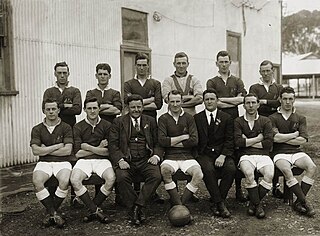
The Melbourne Cricket Ground (MCG), also known locally as The 'G, is a sports stadium located in Yarra Park, Melbourne, Victoria. Founded and managed by the Melbourne Cricket Club, it is the largest stadium in the Southern Hemisphere, the 11th largest globally, and the second-largest cricket arena by capacity. The MCG is within walking distance of the Melbourne CBD and is served by Richmond and Jolimont railway stations, as well as the route 70, 75 and 48 trams. It is adjacent to Melbourne Park and is an integral part of the Melbourne Sports and Entertainment Precinct.

The Adelaide Oval is a sports ground in Adelaide in the state of South Australia. It is located in the parklands between the city centre and North Adelaide. The venue is predominantly used for cricket and Australian rules football, but has also played host to rugby league, rugby union, soccer, and tennis, as well as regularly being used to hold concerts.

John Dyson is a former international cricketer (batsman) who is now a cricket coach, most recently in charge of the West Indies.

Sydney Edward Gregory, sometimes known as Edward Sydney Gregory, was a cricketer who played for New South Wales and Australia. At the time of his retirement, he had played a world-record 58 Test matches during a career spanning 1890 to 1912. A right-handed batsman, he was also a renowned fielder, particularly at cover point.
Robert George Holland was a New South Wales and Australian cricketer. He was, because of his surname, nicknamed "Dutchy".
Bruce Malcolm Laird is a former Western Australian and Australian cricketer. He was an opening batsmen who played in 21 Test matches and 23 One Day Internationals. He also played 13 "Supertests" in World Series Cricket. He was a part of the Australian squad which finished as runners-up at the 1975 Cricket World Cup.
Steven Barry Smith is a former Australian and New South Wales cricketer. He played in three Test matches and 28 One Day Internationals between 1983 and 1985, taking part in tours of Sri Lanka, the West Indies, and India.

Alan Geoffrey Fairfax was an Australian cricketer who played in ten Test matches from 1929 to 1931. He was an all rounder.

In New South Wales, Australian rules football dates back to the 1860s colonial era, with organised competitions being continuous since the 1880s. It is traditionally popular in the outback areas of the state near the Victorian and South Australian borders— in the Murray Region, in the Riverina and in Broken Hill. These areas form part of an Australian cultural divide described as the Barassi Line. To the west of the line it is commonly known as "football" or "Australian Football" and to east of the line, it is promoted under the acronym "AFL" by the main development body AFL NSW/ACT. There are more than 15 regional leagues though some are run from other states, the highest profile are AFL Sydney and the Riverina Football Netball League. With 80,572 registered players, it has the third most of any jurisdiction.
Wilfred Wooller was a Welsh sportsman, cricket administrator, and journalist.

Reg Date was an Australian soccer player who plied his trade after the Second World War. Date played for Wallsend Football Club and Canterbury-Bankstown. He represented Australia in five full international matches, captaining three times.
Alex Gibb was an Australian soccer player who played half-back with Queensland clubs and the Queensland and Australia national teams. Gibb is recognised as Australia's first international captain, and was awarded Socceroo cap number one retrospectively in 2000 by Football Federation Australia, for Australia's first Test match against New Zealand, played in 1922.

Alfred Quill was an Australian soccer player and played for the Australia national team. Often considered one of the best soccer players in New South Wales, he scored 868 goals in all NSW competitions in his 24-year senior career.
The 1932 Great Britain Lions tour was a tour by the Great Britain national rugby league team) of Australia and New Zealand which took place between May and August 1932. The tour involved a schedule of 26 games, 18 in Australia including a three-test series against Australia for the Ashes and a further eight in New Zealand including a three-test series against New Zealand.
The 1946 Great Britain Lions tour was a tour by the Great Britain national rugby league team of Australia and New Zealand which took place between April and August 1946. The tour involved a schedule of 27 games: 20 in Australia including a three-test series against Australia for the Ashes, and a further 7 in New Zealand including one test match against New Zealand.
George Smith was an Australian professional soccer player who played as a forward. He captained the Australia national soccer team in 1933. Often considered the best centre-forward in Australian soccer in the 1930s, he had an average of 2.66 goals per game for Australia and has had many goalscoring records throughout his 17-year career.
Jack Gilmore was a former Australian professional soccer player who played as a forward for NSW club Weston and the Australia national soccer team.
Alec Cameron was an Australian professional soccer player who played as a forward and captained the Australia national soccer team.
This article summarises the Australia men's national soccer team in 1923.

This article summarises the Australia men's national soccer team in 1924.








